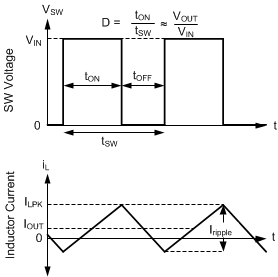SNVSCI2B February 2023 – February 2024 TLVM23615 , TLVM23625
PRODUCTION DATA
- 1
- 1 Features
- 2 Applications
- 3 Description
- 4 Device Comparison Table
- 5 Pin Configuration and Functions
- 6 Specifications
-
7 Detailed Description
- 7.1 Overview
- 7.2 Functional Block Diagram
- 7.3
Feature Description
- 7.3.1 Input Voltage Range
- 7.3.2 Output Voltage Selection
- 7.3.3 Input Capacitors
- 7.3.4 Output Capacitors
- 7.3.5 Enable, Start-Up, and Shutdown
- 7.3.6 Switching Frequency (RT)
- 7.3.7 Power-Good Output Operation
- 7.3.8 Internal LDO, VCC and VOUT/FB Input
- 7.3.9 Bootstrap Voltage and VBOOT-UVLO (BOOT Terminal)
- 7.3.10 Soft Start and Recovery from Dropout
- 7.3.11 Overcurrent Protection (Hiccup Mode)
- 7.3.12 Thermal Shutdown
- 7.4 Device Functional Modes
-
8 Application and Implementation
- 8.1 Application Information
- 8.2
Typical Application
- 8.2.1 Design Requirements
- 8.2.2
Detailed Design Procedure
- 8.2.2.1 Custom Design With WEBENCH® Tools
- 8.2.2.2 Choosing the Switching Frequency
- 8.2.2.3 Setting the Output Voltage
- 8.2.2.4 Input Capacitor Selection
- 8.2.2.5 Output Capacitor Selection
- 8.2.2.6 VCC
- 8.2.2.7 CFF Selection
- 8.2.2.8 Power-Good Signal
- 8.2.2.9 Maximum Ambient Temperature
- 8.2.2.10 Other Connections
- 8.2.3 Application Curves
- 8.3 Best Design Practices
- 8.4 Power Supply Recommendations
- 8.5 Layout
- 9 Device and Documentation Support
- 10Revision History
- 11Mechanical, Packaging, and Orderable Information
Package Options
Mechanical Data (Package|Pins)
- RDN|11
Thermal pad, mechanical data (Package|Pins)
- RDN|11
Orderable Information
7.4.3.3 FPWM Mode – Light-Load Operation
In FPWM mode, frequency is maintained while the output is lightly loaded. To maintain frequency, a limited reverse current is allowed to flow through the inductor. Reverse current is limited by negative current limit circuitry, see Electrical Characteristics for negative current limit values.

In FPWM mode, Continuous Conduction (CCM) is possible even if IOUT is less than half of Iripple.
Figure 7-12 FPWM Mode OperationFor all devices, in FPWM mode, frequency reduction is still available if output voltage is high enough to command minimum on time even while lightly loaded, allowing good behavior during faults which involve output being pulled up.